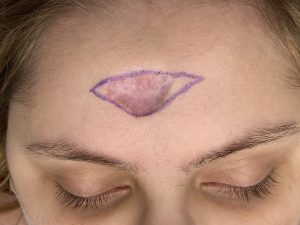Background: Improvement of scars is a common request for which a variety of techniques exist to do so. Surgical treatment is indicated when the scars are hypertrophic (raised and wide) or have a depressed contour to them. Laser and various injection therapies have a role when scars are generally flat and improvement is needed in its color or texture.
In surgical scar revisions some patients may be under the impression that the resultant surgery will make the scar disappear or will be invisible afterwards.This is an erroneous belief. The term scar revision should be replaced by the more accurate term scar replacement…as that is what actually occurs. The existing scar is completely removed and then put back together either in a straight line or some form of geometric closure pattern. A scar will still exist but the goal/hope is that it will look better than the scar it replaced.
Thus the decision about the merits to surgical scar revision is how likely will the scar replacement look better than the original scar. That depends on numerous factors but the most important one is what does the original scar look like.



While scar revision is always a gamble it is has less risk in some scars. While the scar revision outcome remains to be seen in this patient it is fair to say that no matter how not turns out it will be better than the original scar.
This case illustrates that in some scars whatever the scar tradeoff is it is bound to be better. But not all scar revisions are so obvious for improvement and each scar must be considered individually to weigh the likelihood that a scar revision is worth the effort.
Key Points:
1) Scar revision is about exchanging one scar for another with the hope that the replacement scar looks better.
2) Scar revision will always leave a residual scar.
3) While multiple scars revisions techniques exist in many cases simple excision and linear closure is what is needed.
Dr. Barry Eppley
World-Renowned Plastic Surgeon



